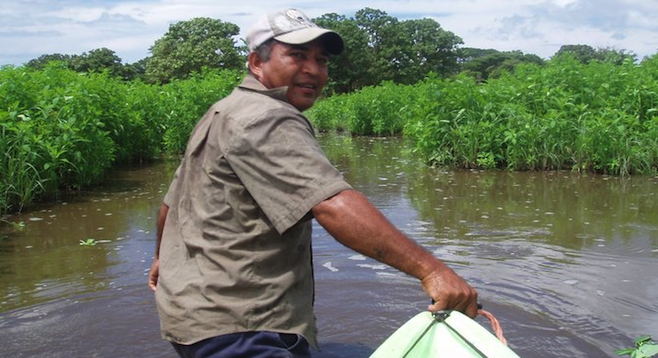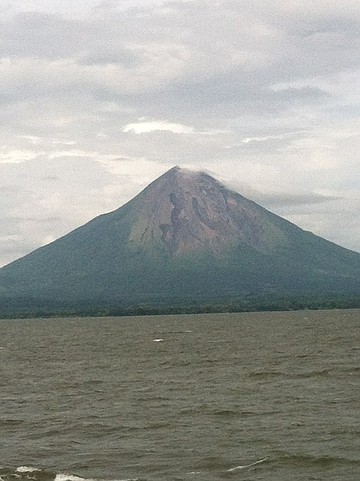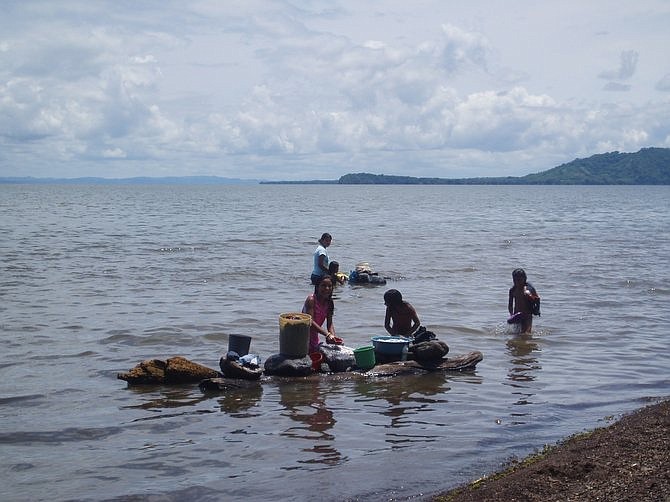 Facebook
Facebook
 X
X
 Instagram
Instagram
 TikTok
TikTok
 Youtube
Youtube

Approaching the island of Ometepe is a bit foreboding.

As the ferry moves nearer and nearer, it's too easy to invoke movie images of Jurassic Park or King Kong. The tops of the two volcanoes are more often than not obscured in clouds. Or could it be CO2?
The island is formed by two volcanoes: one dormant, the other active. One is lush tropical rainforest; the other, Concepcion, has sides stripped bare, exposing the cone. Forest is replaced by sheer volcanic rock.
All fears are quickly dashed when the ferry lands at the small town of Moyogalpa. We made the mistake of taking our rental car with us. Not only is a car unnecessary, but it cost an extra $60 for the transportation. Plus only a few roads are passable without four-wheel drive. Since there are no traffic lights, they have speed bumps – more aptly described as speed humps. Sitting at least six inches high and a foot across, they definitely slow you down.
The town opens up onto one main street. It supports restaurants, hotels and hostels. Taxis, bicycles and motorcycles are available for rent.
We eventually rented a small 250cc motorcycle and were able to explore any part of the island we wished. Many of the roads felt more like a motocross course than a point of passage.
A small strait of land connects the two volcanoes and is home to Rio Isthian. For $20 you can take a three-hour kayak tour along the shore of Lake Nicaragua and into the swamp and river.

On the lake we passed fishing boats and women hand-washing clothes on rocks projecting from the water (left). After about an hour of paddling, we arrived at the mouth of the river. Since the rainy season had not yet begun, our guide was forced to pull the kayak through the sludge until we hit the swamp.
The word "remote" is used so often, but when we once again put our paddles in the water and moved toward the interior of the island I felt I truly understood the definition. The abundance of life was overwhelming. The black water spread out, surrounded by rainforest on both sides where the intensity of green gave the color new meaning.
It was a birding paradise: Great white egrets stood like sentries over our passage, holding to the last minute before lifting off the water effortlessly. So close we could hear their wingbeats and see an occasional feather fall. Birds were everywhere. Along with the egrets, we spotted green herons, whistling ducks and black vultures, just to name a few.
Not to be out done by their avian brothers, iguanas peered out at us from shore and turtles lazed on fallen trees.
Highlighting the adventure were the caiman (or as our guide referred to them, alligators). Their sinister, prehistoric-looking eyes and snouts barely broke the surface, watching us as we paddled by. We were treated to the sight of one of the reptiles propelling half its body above the water line and feasting on a fish.
If Nicaragua’s beauty is a secret to many, Ometepe is top secret, and Rio Isthian was certainly for “our eyes” only. Like the rest of the country, the tour was inexpensive and worth multiple times the cost.


Approaching the island of Ometepe is a bit foreboding.

As the ferry moves nearer and nearer, it's too easy to invoke movie images of Jurassic Park or King Kong. The tops of the two volcanoes are more often than not obscured in clouds. Or could it be CO2?
The island is formed by two volcanoes: one dormant, the other active. One is lush tropical rainforest; the other, Concepcion, has sides stripped bare, exposing the cone. Forest is replaced by sheer volcanic rock.
All fears are quickly dashed when the ferry lands at the small town of Moyogalpa. We made the mistake of taking our rental car with us. Not only is a car unnecessary, but it cost an extra $60 for the transportation. Plus only a few roads are passable without four-wheel drive. Since there are no traffic lights, they have speed bumps – more aptly described as speed humps. Sitting at least six inches high and a foot across, they definitely slow you down.
The town opens up onto one main street. It supports restaurants, hotels and hostels. Taxis, bicycles and motorcycles are available for rent.
We eventually rented a small 250cc motorcycle and were able to explore any part of the island we wished. Many of the roads felt more like a motocross course than a point of passage.
A small strait of land connects the two volcanoes and is home to Rio Isthian. For $20 you can take a three-hour kayak tour along the shore of Lake Nicaragua and into the swamp and river.

On the lake we passed fishing boats and women hand-washing clothes on rocks projecting from the water (left). After about an hour of paddling, we arrived at the mouth of the river. Since the rainy season had not yet begun, our guide was forced to pull the kayak through the sludge until we hit the swamp.
The word "remote" is used so often, but when we once again put our paddles in the water and moved toward the interior of the island I felt I truly understood the definition. The abundance of life was overwhelming. The black water spread out, surrounded by rainforest on both sides where the intensity of green gave the color new meaning.
It was a birding paradise: Great white egrets stood like sentries over our passage, holding to the last minute before lifting off the water effortlessly. So close we could hear their wingbeats and see an occasional feather fall. Birds were everywhere. Along with the egrets, we spotted green herons, whistling ducks and black vultures, just to name a few.
Not to be out done by their avian brothers, iguanas peered out at us from shore and turtles lazed on fallen trees.
Highlighting the adventure were the caiman (or as our guide referred to them, alligators). Their sinister, prehistoric-looking eyes and snouts barely broke the surface, watching us as we paddled by. We were treated to the sight of one of the reptiles propelling half its body above the water line and feasting on a fish.
If Nicaragua’s beauty is a secret to many, Ometepe is top secret, and Rio Isthian was certainly for “our eyes” only. Like the rest of the country, the tour was inexpensive and worth multiple times the cost.
Comments